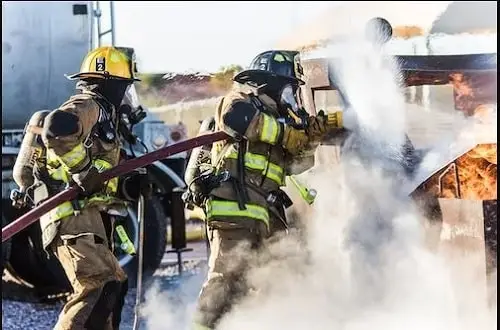firefighting extinguishing foam, also known as AFFF (abyssal film-forming foam), is used to extinguish fires by covering flames with a blanket of water. It is highly effective but also contains toxic chemicals.
These ingredients have been linked to cancer and other illnesses, and many firefighters have come forward with complaints about their health after exposure to AFFF.
What Is AFFF?
AFFF is a fluorocarbon-based firefighting foam used to extinguish fires at airports, military bases, and industrial plants. It is commonly used for firefighting training as well as for suppressing fires in aircraft.
The chemicals that makeup AFFF are considered safe for humans by the EPA and many other regulatory agencies when used according to directions.
Use Of AFFF And AFFF Foam
AFFF is used in airplanes, ships, and firefighting. It is used to fight fires in both military and civilian settings. This foam can be used on land as well as at sea. AFFF contains water and other chemical ingredients, such as ethylene and propylene glycol, which extend the shelf life of the foam. Fire extinguishing foam is sold as a concentrate that is mixed with water. Depending on how much water is in the mix, it comes in three percent and six percent formulas.
AFFF is a fluorocarbon-based synthetic liquid also known as “aqueous film-forming foam” or simply “fire-fighting foam”. AFFF contains both water and detergent chemicals that can be sprayed onto any flammable material and quickly extinguished without damaging nearby structures or materials and without risking harm to humans who come into contact with it. Can be ignited.
Some sources suggest that AFFF is one of the most effective methods of controlling fuel fires because its unique chemical makeup helps prevent re-ignition after use. In fact, many experts believe that this type of material should replace carbon dioxide extinguishers because it has proven over time to be more effective at preventing post-ignition than CO2.
However, there are many advantages associated with using AFFF as opposed to other types of CO2 fire extinguishers. Some are concerned about potential health risks associated with exposure over time, primarily because these varieties do not contain harmful agents such as chlorine dioxide, which can potentially cause long-term effects.
AFFF And Toxic Ingredients Of Concern
AFFF products commonly used in the US contain PFOA, a suspected carcinogen and endocrine disruptor that can cause reproductive and developmental problems. PFOA has also been linked to other health effects, including high cholesterol levels, ulcerative colitis, and thyroid disease. The extent of human exposure to PFAS varies by occupation & region. These synthetic substances have polluted our soil, air, and water. People are usually exposed to PFAS by breathing in air contaminated with PFAS, using products containing PFAS, or drinking contaminated water or food. Human exposure assessment is ongoing.
In one study, the Centers for Disease Control and Prevention’s National Health and Nutrition Examination Survey (NHANES) discovered that 97% of Americans have PFAS in their blood.
The EPA has set a limit of 70 parts per trillion for perfluorooctanoic acid in drinking water. This regulation is based on human exposure to PFOA from food only. EPA has not evaluated how much exposure people actually receive from their drinking water where AFFF may be used at airports or military bases near waterways that flow into open bodies of water such as streams & lakes. I fall where there is regular swimming during the summer months when the temperature rises. Above 85 degrees Fahrenheit (29 Celsius).
The Firefighter Foam Cancer Lawsuit
Aqueous film-forming foam (AFFF), sometimes called “firefighting foam,” contains chemicals that can cause several cancers. You may be eligible to file an AFFF lawsuit and receive financial compensation if you were a firefighter or frequently exposed to AFFF and were recently diagnosed with kidney, pancreatic, prostate, or testicular cancer.
The Judicial Panel on Multidistrict Litigation (JPMDL) mandates that all federal litigation must now be filed in the United States Federal Court for the District of South Carolina. As of September 2022, approximately 2,500 AFFF plaintiffs remained in litigation.
Therefore, a single judge will preside over all AFFF firefighting foam cancer complaints filed in federal court. It is hoped that this will be the first step towards a global agreement on firefighting foam.
Health Problems Associated With Exposure To AFFF
It is important to understand the symptoms associated with exposure to AFFF. Skin irritation, eye irritation, and burning sensation are common symptoms of short-term exposure. These can be caused by the degradation of perfluorooctanoic acid (PFOA), which is found in AFFF foam. A new study published in a medical journal shows just how much harm this substance can cause. According to the study authors, women exposed to PFAS had a 42% to 47% higher risk of developing high blood pressure.
The study adds to the body of evidence linking PFAS chemicals to an increased risk of heart disease. Those in the study who had high levels of PFAS in their bodies were 71 percent more likely to have high blood pressure. In addition, 470 of the 1,058 women who participated in the study were diagnosed with high blood pressure between 1999 and 2017.
In addition, long-term exposure has been linked to respiratory problems, including fluid in the lungs & asthma.
With so much focus on firefighter safety, it’s important that we recognize how much work has already been done to make firefighting foam safer.
Additionally, firefighting foam is only a small part of the many ways firefighters are exposed to flame retardants or other toxic materials during their careers. It’s also important to remember that there are many substances used in commercial products in our homes and offices today that may carry similar risks to those commonly used by firefighters.


